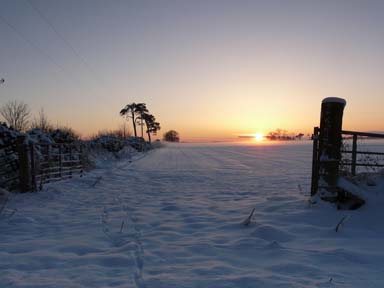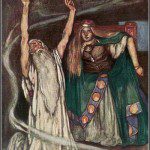
What can a naturalist celebrate in December? This post is part of Naturalistic Traditions, a column exploring naturalism in Pagan ways. This column will cover seasonal celebrations, historical and contemporary movements, and ritual practices.
Natural Cycles
For places in the northern hemisphere, winter has arrived. Snow pricks your cheeks, and naked branches rattle in the wind. The day of longest darkness, after which the sun begins to return, comes on December 21st as the Winter Solstice. As for lunar cycles, the 13th will see a new moon, with a full moon on the 28th.
Neopagan Traditions
In the Northern Hemisphere, the solstice is celebrated as Yule. This year, the date falls on December 21st. The precise date and time for the cross-quarter can be found at archaeoastronomy.com. According to Mike Nichols, the winter solstice is the time when the Goddess gives birth to the new Sun King. He observes:
[I]t makes perfect poetic sense that on the longest night of the winter, “the dark night of our souls,” there springs the new spark of hope, the Sacred Fire, the Light of the World, the Coel Coeth.
Nichols further asserts that the name for the festival, Yule, comes from the Anglo-Saxon yula, meaning “wheel” of the year. Regarding the Yule log, he says:
Once, the Yule log had been the center of the celebration. It was lighted on the eve of the solstice (it should light on the first try) and must be kept burning for twelve hours, for good luck. It should be made of ash. Later, the Yule log was replaced by the Yule tree but, instead of burning it, lighted candles were placed on it.
Glenys Livingstone of Pagaiantransposes the solstice onto the birth of the universe itself. Her ritual script sees all lights extinguished and, after a time in the darkness, a fire is kindled with the following words:
“We recall our Beginnings – the Great Flaring Forth, and our Grandmother Supernova Tiamat – Goddess Mother of our Solar system, of our star the Sun. This is our Cosmic lineage. We are Gift of Tiamat – Goddess Mother supernova. Out of her stardust we are born. Carbon, hydrogen, oxygen, nitrogen, sulphur, phosphorus and trace elements. We are Gift of Tiamat – out of her stardust we are born.”
Jon Cleland Host of the Naturalistic Paganism Yahoo group celebrates the solstice with his family, including Yule log and sunrise viewing:
A Yule log can be made and burned. This is done by selecting and cutting the log, then taking it inside for decoration. Kids can contribute by helping with the decorations. Some Pagans use the log as a stand for candles, and light the candles (especially for apartment dwellers, or those without a fireplace) on Solstice eve. Others actually burn the log on Solstice eve, lighting it with a small piece of the log from the previous year. More can be found on the web about the tradition of the Yule Log. A tradition practiced in my family, but not apparently very widespread, is to get up to welcome the sunrise on the morning of the Winter Solstice. This is often done from a location where the horizon can be seen, such as the shore of Lake Huron or Michigan. The weather is often cloudy, so knowing the exact minute of the sunrise is important. A short ritual can be done to greet the rising sun, and poems or readings can be read. Long rituals are not recommended due to the cold temperatures usually seen on the morning of Solstice (not to mention that long rituals aren’t fun for kids). After returning from that, the stockings are found to be filled, and presents appear. In the past they appeared under the Yule/Solstice tree, this year they appeared in the center of our stone circle outside.
Meanwhile, those in the Southern Hemisphere experience this time as Midsummer.
Civic and Scientific Traditions
All year, we’ve noted sparse reminders of the evolving universe. Now, in the final month, the calendar kicks into high gear as virtually everything familiar to us happens in history’s last few moments, including all of civilization in the final thirty seconds of the last day. Jon Cleland Host shares the experience with his children, calling out momentous events by the tick of a watch, as history whizzes by in the last few seconds before midnight. The following tables are from Wikipedia:
Evolution of life
| Date | bya | Event |
|---|---|---|
| 21 Sep | 3.8 | first life (prokaryotes) |
| 12 Oct | 3 | photosynthesis |
| 29 Oct | 2.4 | Oxygenation of atmosphere |
| 8 Nov | 2 | complex cells (eukaryotes) |
| 5 Dec | 1 | first multicellular life |
| 14 Dec | 0.67 | simple animals |
| 14 Dec | 0.55 | arthropods (ancestors of insects, arachnids) |
| 18 Dec | 0.5 | fish and proto-amphibians |
| 20 Dec | 0.45 | land plants |
| 21 Dec | 0.4 | insects and seeds |
| 22 Dec | 0.36 | amphibians |
| 23 Dec | 0.3 | reptiles |
| 26 Dec | 0.2 | mammals |
| 27 Dec | 0.15 | birds |
| 28 Dec | 0.13 | flowers |
| 30 Dec | 0.065 | Cretaceous–Paleogene extinction event, non-avian dinosaurs die out |
Human evolution
| Date / time | mya | Event |
|---|---|---|
| 30 Dec | 65 | Primates |
| 31 Dec, 06:05 | 15 | Apes |
| 31 Dec, 14:24 | 15 | hominids |
| 31 Dec, 22:24 | 2.5 | primitive humans and stone tools |
| 31 Dec, 23:44 | 0.4 | Domestication of fire |
| 31 Dec, 23:52 | 0.2 | Anatomically modern humans |
| 31 Dec, 23:55 | 0.11 | Beginning of most recent glacial period |
| 31 Dec, 23:58 | 0.035 | sculpture and painting |
| 31 Dec, 23:59:32 | 0.012 | Agriculture |
History begins
| Date / time | kya | Event |
|---|---|---|
| 31 Dec, 23:59:47 | 5.5 | First writing (marks end of prehistory and beginning of history), beginning of the Bronze Age |
| 31 Dec, 23:59:48 | 5.0 | First dynasty of Egypt, Early Dynastic period in Sumer, Astronomy |
| 31 Dec, 23:59:49 | 4.5 | Alphabet, Akkadian Empire, Wheel |
| 31 Dec, 23:59:51 | 4.0 | Code of Hammurabi, Middle Kingdom of Egypt |
| 31 Dec, 23:59:52 | 3.5 | Mycenaean Greece; Olmec civilization; Iron Age in Near East, India, and Europe; founding of Carthage |
| 31 Dec, 23:59:53 | 3.0 | Kingdom of Israel, ancient Olympic games |
| 31 Dec, 23:59:54 | 2.5 | Buddha, Confucius, Qin Dynasty, Classical Greece, Ashokan Empire, Vedas completed, Euclidean geometry, Archimedean physics, Roman Republic |
| 31 Dec, 23:59:55 | 2.0 | Ptolemaic astronomy, Roman Empire, Christ, invention of numeral 0 |
| 31 Dec, 23:59:56 | 1.5 | Muhammad, Maya civilization, Song Dynasty, rise of Byzantine Empire |
| 31 Dec, 23:59:58 | 1.0 | Mongol Empire, Crusades, Christopher Columbus voyages to the Americas, Renaissance in Europe |
The current second
| Date / time | kya | Event |
|---|---|---|
| 31 Dec, 23:59:59 | 0.5 | modern science and technology, American Revolution, French revolution, World War I, World War II, Apollo Moon landing |
Isaac Newton’s birthday
 Finally, December 25th is known as the birthday of a certain famous child, who brought light into the world. I’m talking of course about the baby Isaac Newton, who later used a prism to split light into the spectrum of the rainbow. Sir Isaac Newton, born December 25th, 1642, was the genius behind the physics that reigned before relativity and quantum mechanics, and which is still used today for most terrestrial-scale calculations.
Finally, December 25th is known as the birthday of a certain famous child, who brought light into the world. I’m talking of course about the baby Isaac Newton, who later used a prism to split light into the spectrum of the rainbow. Sir Isaac Newton, born December 25th, 1642, was the genius behind the physics that reigned before relativity and quantum mechanics, and which is still used today for most terrestrial-scale calculations.
Newton showed that the motion of objects on Earth and that of celestial bodies is governed by the same set of natural laws: by demonstrating the consistency between Kepler’s laws of planetary motion and his theory of gravitation he removed the last doubts about heliocentrism and advanced the scientific revolution. The Principia is generally considered to be one of the most important scientific books ever written, both due to the specific physical laws the work successfully described, and for its style, which assisted in setting standards for scientific publication down to the present time. Newton built the first practical reflecting telescope[9] and developed a theory of colour based on the observation that a prism decomposes white light into the many colours that form the visible spectrum. He also formulated an empirical law of cooling and studied the speed of sound. In mathematics, Newton shares the credit with Gottfried Leibniz for the development of differential and integral calculus. He generalised the binomial theorem to non-integer exponents, developed Newton’s method for approximating the roots of a function, and contributed to the study of power series. Although an unorthodox Christian, Newton was deeply religious and wrote more on Biblical hermeneutics and occult studies than on science and mathematics. He secretly rejected Trinitarianism and refused holy orders. (Wikipedia)
About the author
B. T. Newberg has been practicing meditation and ritual from a naturalistic perspective since 2000. After experimenting with Agnosticism, Buddhism, Contemporary Paganism, and Spiritual Humanism, he currently combines the latter two into a dynamic path embracing both science and myth. He is the editor of a community blog for naturalistic spirituality called Humanistic Paganism, which just published an anthology called Year One with over a dozen contributing authors. After growing up in Minnesota, and living in England, Malaysia, and Japan, B. T. Newberg currently resides in South Korea with his wife and cat.


















